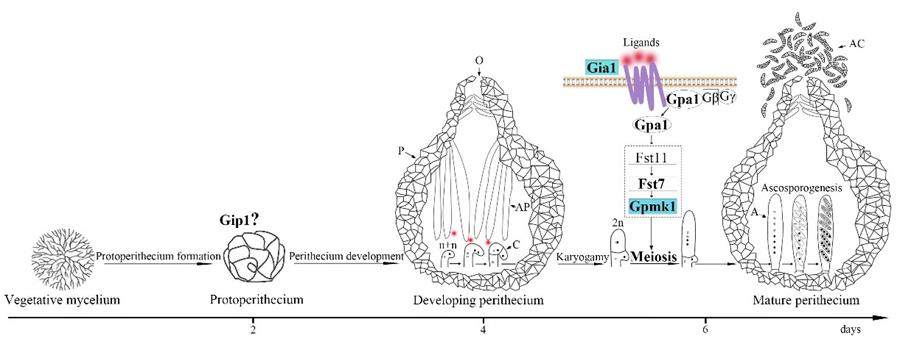Recently, the Functional Genomics of Plant Pathogenic Fungi Research Team from our college published a research paper titled "A non-pheromone GPCR is essential for meiosis and ascosporogenesis in the wheat scab fungus" online in the Proceedings of the National Academy of Sciences of the United States of America (PNAS). The study pioneered the discovery of a novel non-pheromone-dependent G-protein-coupled receptor essential for sexual reproduction (ascospore formation) in wheat scab fungus, revealing its mediated signaling pathways and critical roles in meiosis and ascospore formation, breaking traditional understanding of fungal sexual reproduction signal recognition, and providing a theoretical basis for developing receptor interference-based pathogen control technologies.

The formation and development of ascospore shells in wheat scab fungi belong to the sexual reproduction process, and the initiation and transition of different stages of fungal sexual reproduction rely on molecular recognition and signal transduction mediated by membrane receptors. In the model fungus Saccharomyces cerevisiae, pheromone receptors perceive pheromones as a necessary condition for sexual development. However, in the sexual reproduction process of wheat scab fungi (Fusarium graminearum), pheromones and their receptors are not necessary. Are there other receptors controlling the initiation and progress of sexual development in wheat scab fungi? The group systematically knocked out all GPCRs of Fusarium graminearum and identified the infection-related GPCR subfamily (Nature Microbiology, 2019). Through phenotypic identification of a large number of GPCR mutants, it was found that one mutant had normal ascospore shell morphology but no ascospores were released. Further comprehensive temporal and spatial observation of ascospore shell development in the mutant revealed that the necessary meiosis for ascospore development could not occur. Therefore, this GPCR recognition signal is a necessary condition for initiating meiosis and ascospore development, and this GPCR was named Gia1. Through continuous activation of the signaling pathway, it was revealed that the signal recognized by Gia1 is transmitted intracellularly through the Gpmk1 MAPK signaling pathway.
The function of Gia1 is also conserved in heterothallic Neurospora crassa. Evolutionary analysis of Gia1 showed that this receptor is only distributed in the Pezizomycotina, with a paralogous homologous receptor present in the order Hypocreales. The mutant ascospore shells of the paralogous homologous receptor could not form, and this receptor was named Gip1. Gip1 and Gia1 regulate ascospore shell formation and ascospore development, respectively, through stage-specific expression, effectively ensuring the orderly occurrence of sexual development. Key regions determining functional differentiation between receptors were identified through promoter and protein segment swapping. Based on Alphafold2 structure prediction, it was found that the N-terminal extracellular region and the third extracellular loop are spatially close, possibly responsible for ligand recognition, while the third intracellular loop and the C-terminal intracellular region mediate intracellular signal transduction.
The study also modified the yeast system, using Fus1 responsible for pheromone response in yeast as a reporter gene, and cleverly replaced the extracellular region of the yeast pheromone receptor with the extracellular region of Gia1 to construct an efficient ligand screening system. Extracts from different stages of Fusarium graminearum were applied to this system, and specific ligands were found to be highly enriched in Fusarium graminearum ascospore shells. After heat inactivation and proteinase treatment, the signal disappeared, suggesting that the ligand is a protein, laying an important foundation for the precise identification of subsequent ligands.

Functional model of key receptors in sexual reproduction of fusarium graminearum
Ding Mingyu and Cao Shulin, the Ph.D students in our college, are co-first authors. Prof. Jiang Cong from our college and Prof. J.R. Xu from Purdue University, USA, are co-corresponding authors of the paper. Prof. Liu Huiquan, Associate Professor Wang Qinhua, and several other graduate students from the research group also participated in this work. This research was supported by the National Key Research and Development Program, the National Natural Science Foundation of China, and other projects. The Experimental Platform of State Key laboratory for Crop Stress Resistance and High-Efficiency Production provided important technical support for the completion of this research work.
Original link: https: //www.pnas.org/doi/10.1073/pnas.2313034120